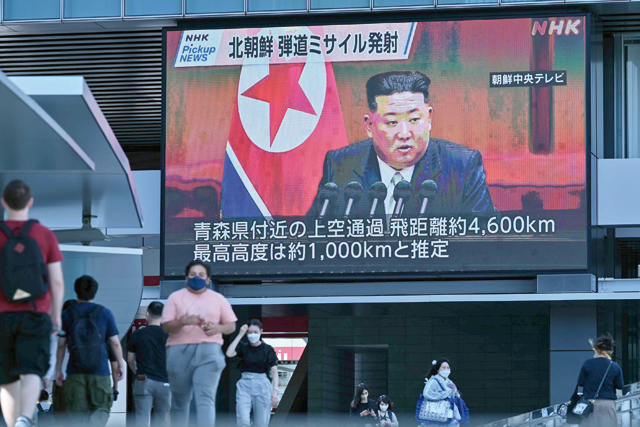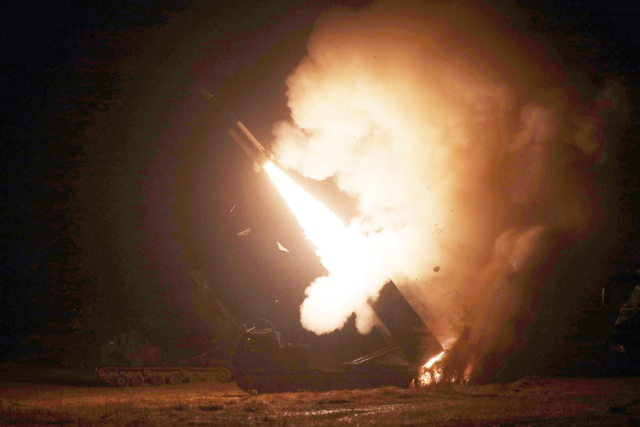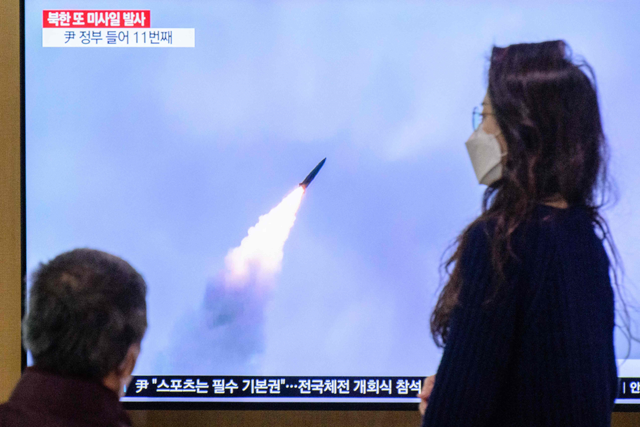You are here
North Korea fires ballistic missile over Japan
By AFP - Oct 04,2022 - Last updated at Oct 04,2022

Pedestrians walk under a large video screen showing images of North Korea’s leader Kim Jong-un during a news update in Tokyo, on Tuesday (AFP photo)
SEOUL — North Korea fired a ballistic missile over Japan for the first time in five years on Tuesday, prompting Tokyo to activate its missile alert system and issue a rare warning for people to take shelter.
The latest launch — which the United States branded “reckless and dangerous” — comes in a record year of sanctions-busting weapons tests by North Korea, which recently revised its laws to declare itself an “irreversible” nuclear power.
The last time Pyongyang fired a missile over Japan was in 2017, at the height of a period of “fire and fury” when North Korean leader Kim Jong-un traded insults with US president Donald Trump.
South Korea said the intermediate-range ballistic missile flew some 4,500 kilometres — possibly a new distance record for North Korean tests, which are usually conducted on a lofted trajectory to avoid flying over neighbouring countries.
South Korean President Yoon Suk-yeol called the launch a “provocation” that violated UN regulations, and vowed a “stern response”, in a statement issued by his office.
Later Tuesday, South Korean and US fighter jets carried out a “precision bombing drill” in response, Seoul’s military said, with South Korean F-15Ks dropping joint direct attack munitions at a target in the Yellow Sea.
The drills aimed to demonstrate the allies’ “capabilities to conduct a precision strike at the origin of provocations”, South Korea’s joint chiefs of staff said in a statement.
On the same day, eight Japanese and four US fighter jets carried out a joint drill in airspace west of the country’s Kyushu region, according to Japan’s joint staff.
The forces “confirmed their readiness and demonstrated domestically and abroad the strong determination of Japan and the United States to deal with any situation”, it said in a statement.
Japanese Prime Minister Fumio Kishida described Pyongyang’s latest test as “an act of violence”, while European Union head Charles Michel called it “an unjustified aggression”.
The US State Department said the “reckless and dangerous launch” posed “an unacceptable threat to the Japanese public”.
Japanese Defence Minister Yasukazu Hamada said the missile could have been a Hwasong-12.
Pyongyang used Hwasong-12s the last two times it fired missiles over Japan — in August and September 2017 — tweeted Chad O’Carroll of specialist site NK News.
Japan activated its missile warning system and urged people in two northern regions of the country to take shelter early Tuesday.
Nuclear message
The Tuesday test is Pyongyang’s fifth missile launch in 10 days and sends a clear message to the United States, Park Won-gon, professor of North Korean Studies at Ewha University in Seoul, told AFP.
The missiles “put South Korea, Japan, and Guam within range”, and show that Pyongyang could hit US bases with nukes if war broke out on the Korean Peninsula, he said.
“As these are missiles that can carry nuclear warheads, the launch also has a political goal of once again declaring North Korea a de facto nuclear power and showing its complete de-nuclearisation is impossible,” Park added.
Seoul, Tokyo and Washington have been ramping up joint military drills to counter Pyongyang’s growing threats, staging the first trilateral anti-submarine drills in five years Friday.
That came just days after the US and South Korean navies conducted large-scale exercises.
Such drills infuriate North Korea, which sees them as rehearsals for an invasion.
US Vice President Kamala Harris visited Seoul last week and toured the heavily fortified De-militarised Zone that divides the Korean peninsula, on a trip to underscore her country’s “ironclad” commitment to South Korea’s defence.
About 28,500 US troops are stationed in South Korea to help protect it from the North.
Significant escalation
Firing a missile over Japan represented a “significant escalation” by North Korea, said Leif-Eric Easley, a professor at Ewha University.
“Pyongyang is still in the middle of a provocation and testing cycle,” he added.
South Korean and US officials have been warning for months that Kim is preparing to conduct another nuclear test, saying last week that this could happen soon after Pyongyang’s key ally China holds a Communist Party congress from October 16.
Pyongyang has tested nuclear weapons six times since 2006, most recently in 2017.
“North Korea always starts with a low-level provocation and gradually raises the level to attract media attention from all over the world,” said Go Myong-hyun, a researcher at the Asan Institute for Policy Studies.
“Their final provocation will probably be a nuclear test,” he said, adding that North Korea had taken the unusual and “very aggressive” step of overflying Japan to attract more attention.
“By launching the missile over Japan, they are showing that their nuclear threat is not just targeting South Korea.”
Related Articles
SEOUL — North Korea fired a ballistic missile over Japan for the first time in five years on Tuesday, prompting Tokyo to activate its missil
SEOUL — The South Korean and US militaries fired a volley of missiles into the sea in response to North Korea firing a ballistic missile ove
SEOUL — North Korea fired two ballistic missiles into the sea early Sunday, Seoul's military said, the seventh such launch in two weeks, jus


















